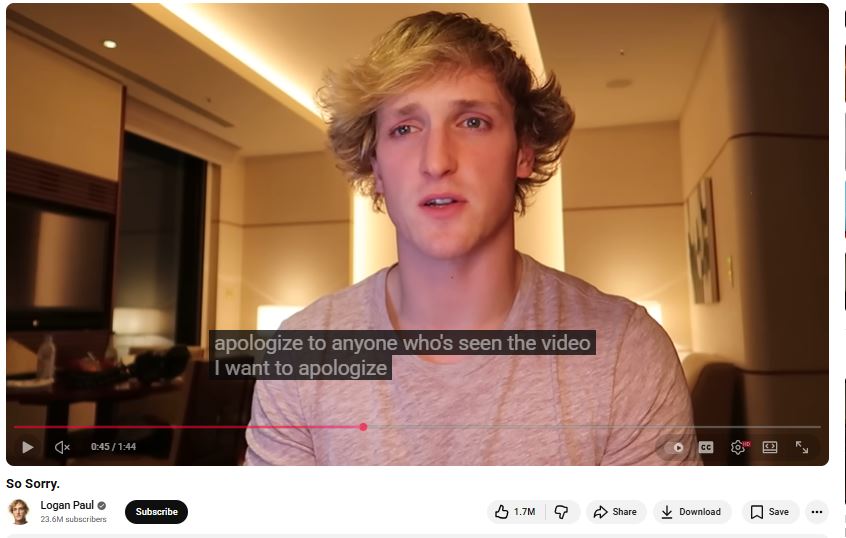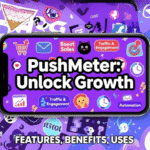Understanding the Context Behind the Controversy
Back in late December 2017, Logan Paul uploaded a video that would change his career forever. The YouTube star traveled to Japan’s Aokigahara forest, known internationally as a location where people go to end their lives. What happened next shocked millions of viewers and sparked one of the biggest controversies in social media history.
Paul filmed what appeared to be a body of a suicide victim and included the footage in his vlog. The video showed him and his friends reacting to the discovery, and while he blurred the person’s face, the content was deeply disturbing. Within hours, the video gained millions of views before Paul took it down. However, the internet never forgets, and screenshots and clips spread rapidly across every platform imaginable.
The Initial Response That Missed the Mark
After removing the video, Logan Paul’s first attempt at addressing the situation came through a written statement on Twitter. This initial response felt rushed and inadequate to many observers. He acknowledged that he had made a mistake but failed to grasp the full weight of what he had done.
The statement read more like damage control than genuine remorse. Paul mentioned that his intention was to raise awareness about suicide and suicide prevention, which struck many as tone-deaf given how he had presented the content. People wanted accountability, not justification. Furthermore, the timing of this response seemed calculated rather than heartfelt, leading critics to question whether he truly understood the gravity of his actions.
Breaking Down the Video Apology Script
Two days after the incident, Logan Paul released a video apology titled “So Sorry.” This marked his second attempt to address the controversy, and unlike his written statement, this one carried more emotional weight. He sat alone in front of the camera, wearing a simple hoodie, with no background music or editing tricks.
The script itself followed a classic apology structure. Paul started by acknowledging that he should have never posted the video. He admitted that he was misguided by a desire to shock people and get views. Throughout the nearly four-minute video, his voice cracked multiple times, and he appeared visibly distressed. Whether genuine or performed, this display of emotion represented a stark contrast to his usual upbeat, high-energy content.
Key Elements That Made the Apology Stand Out
What separated this apology from typical influencer damage control was its stripped-down nature. Logan Paul removed all the production value that typically defined his content. There were no jump cuts, no background music, and no flashy graphics. This deliberate choice communicated that the message mattered more than entertainment value.
Additionally, Paul directly addressed the people most affected by his actions. He spoke specifically to suicide survivors, people who had lost loved ones to suicide, and those struggling with mental health issues. He acknowledged that his video could have triggered painful memories and emotions for vulnerable viewers. This targeted acknowledgment showed a level of awareness that his initial statement lacked completely.
The Public Reaction: Divided Opinions
The internet’s response to Logan Paul’s apology script was anything but unanimous. Some viewers accepted his apology and appreciated that he took responsibility for his actions. They argued that everyone makes mistakes and that young people especially deserve second chances when they show genuine remorse.
However, critics remained unconvinced. Many pointed out that Paul only apologized after facing massive backlash and losing sponsorships. They questioned whether he would have said anything at all if the video hadn’t sparked such intense criticism. Mental health advocates particularly criticized how he initially framed the video as raising awareness, arguing that this showed a fundamental misunderstanding of how to discuss suicide responsibly.
How YouTube Responded to the Incident
YouTube found itself in a difficult position. Logan Paul was one of their biggest stars, bringing in millions of views and substantial advertising revenue. Nevertheless, the platform couldn’t ignore the severity of what had happened. The company issued a statement condemning Paul’s actions and emphasizing their commitment to preventing similar content.
The consequences came swiftly. YouTube removed Logan Paul from their Google Preferred program, which meant he lost access to top-tier advertising opportunities. They also put his YouTube Red projects on hold indefinitely. These actions represented some of the harshest penalties YouTube had imposed on a creator at that time. Still, many argued that a temporary suspension or permanent ban would have sent a stronger message about the platform’s values and content standards.
Understanding the Context Behind the Controversy
Back in late December 2017, Logan Paul uploaded a video that would change his career forever. The YouTube star traveled to Japan’s Aokigahara forest, known internationally as a location where people go to end their lives. What happened next shocked millions of viewers and sparked one of the biggest controversies in social media history.
Paul filmed what appeared to be a body of a suicide victim and included the footage in his vlog. The video showed him and his friends reacting to the discovery, and while he blurred the person’s face, the content was deeply disturbing. Within hours, the video gained millions of views before Paul took it down. However, the internet never forgets, and screenshots and clips spread rapidly across every platform imaginable.
The Initial Response That Missed the Mark
After removing the video, Logan Paul’s first attempt at addressing the situation came through a written statement on Twitter. This initial response felt rushed and inadequate to many observers. He acknowledged that he had made a mistake but failed to grasp the full weight of what he had done.
The statement read more like damage control than genuine remorse. Paul mentioned that his intention was to raise awareness about suicide and suicide prevention, which struck many as tone-deaf given how he had presented the content. People wanted accountability, not justification. Furthermore, the timing of this response seemed calculated rather than heartfelt, leading critics to question whether he truly understood the gravity of his actions.
Breaking Down the Video Apology Script
Two days after the incident, Logan Paul released a video apology titled “So Sorry.” This marked his second attempt to address the controversy, and unlike his written statement, this one carried more emotional weight. He sat alone in front of the camera, wearing a simple hoodie, with no background music or editing tricks.
The script itself followed a classic apology structure. Paul started by acknowledging that he should have never posted the video. He admitted that he was misguided by a desire to shock people and get views. Throughout the nearly four-minute video, his voice cracked multiple times, and he appeared visibly distressed. Whether genuine or performed, this display of emotion represented a stark contrast to his usual upbeat, high-energy content.
Key Elements That Made the Apology Stand Out
What separated this apology from typical influencer damage control was its stripped-down nature. Logan Paul removed all the production value that typically defined his content. There were no jump cuts, no background music, and no flashy graphics. This deliberate choice communicated that the message mattered more than entertainment value.
Additionally, Paul directly addressed the people most affected by his actions. He spoke specifically to suicide survivors, people who had lost loved ones to suicide, and those struggling with mental health issues. He acknowledged that his video could have triggered painful memories and emotions for vulnerable viewers. This targeted acknowledgment showed a level of awareness that his initial statement lacked completely.
The Public Reaction: Divided Opinions
The internet’s response to Logan Paul’s apology script was anything but unanimous. Some viewers accepted his apology and appreciated that he took responsibility for his actions. They argued that everyone makes mistakes and that young people especially deserve second chances when they show genuine remorse.
However, critics remained unconvinced. Many pointed out that Paul only apologized after facing massive backlash and losing sponsorships. They questioned whether he would have said anything at all if the video hadn’t sparked such intense criticism. Mental health advocates particularly criticized how he initially framed the video as raising awareness, arguing that this showed a fundamental misunderstanding of how to discuss suicide responsibly.
How YouTube Responded to the Incident
YouTube found itself in a difficult position. Logan Paul was one of their biggest stars, bringing in millions of views and substantial advertising revenue. Nevertheless, the platform couldn’t ignore the severity of what had happened. The company issued a statement condemning Paul’s actions and emphasizing their commitment to preventing similar content.
The consequences came swiftly. YouTube removed Logan Paul from their Google Preferred program, which meant he lost access to top-tier advertising opportunities. They also put his YouTube Red projects on hold indefinitely. These actions represented some of the harshest penalties YouTube had imposed on a creator at that time. Still, many argued that a temporary suspension or permanent ban would have sent a stronger message about the platform’s values and content standards.
Lessons Content Creators Learned From This Incident
The Logan Paul controversy became a watershed moment for the influencer community. Content creators across platforms started having serious conversations about responsibility, boundaries, and the impact their content has on viewers. Many YouTubers made videos discussing what lines should never be crossed, regardless of views or engagement metrics.
This incident also highlighted the importance of thinking before posting. In the race for daily content and maintaining relevance, creators sometimes prioritize speed over judgment. Logan Paul’s mistake served as a cautionary tale about what happens when shock value takes precedence over basic human decency. Established creators began implementing review processes for sensitive content, and newer influencers learned that not every moment needs to be filmed and shared.
The Long-Term Impact on Logan Paul’s Career
Contrary to what many predicted, Logan Paul’s career didn’t end after this controversy. While he faced significant backlash and financial losses in the immediate aftermath, he gradually rebuilt his reputation. He took a month-long break from daily vlogging and returned with content focused on mental health awareness and suicide prevention.
Paul partnered with organizations dedicated to suicide prevention and donated to various mental health charities. He also shifted his content strategy, moving away from the shock-value approach that had defined his early YouTube career. Today, he’s known for his podcast “Impaульse” and his ventures into professional boxing and WWE wrestling. While some people still associate him primarily with the Japan incident, others view him as someone who learned from a massive mistake and worked to make amends.
What Makes an Effective Apology in the Digital Age
Logan Paul’s apology script offers valuable insights into what works and what doesn’t when public figures need to address controversies. First and foremost, timing matters tremendously. Waiting too long makes you look indifferent, but responding too quickly can seem insincere or unconsidered. Paul’s two-day gap between the incident and his video apology struck a balance that allowed him to craft a more thoughtful response.
Authenticity remains the most critical component of any apology. Viewers can detect when someone is reading from a PR team’s script versus speaking from genuine remorse. The production choices matter too—overly polished apologies often feel corporate and disconnected. Paul’s stripped-down video approach helped convey sincerity, though debates continue about whether his remorse was genuine or strategic. Additionally, specific acknowledgment of who was harmed and how carries more weight than vague statements about “anyone I may have offended.”
Conclusion: The Lasting Legacy of a Controversial Moment
The Logan Paul apology script remains one of the most analyzed pieces of content in YouTube history. It represents a turning point both for Paul as a creator and for the platform’s approach to policing content. While opinions remain divided on whether his apology was sufficient, the incident sparked necessary conversations about mental health, responsible content creation, and the power influencers hold over their audiences.
This controversy taught the digital world several important lessons. Content creators learned that audiences expect accountability when mistakes happen. Platforms learned they need clearer guidelines and swifter action when harmful content appears. Viewers learned to think critically about the media they consume and support. Years later, the incident still gets referenced in discussions about influencer culture, apology videos, and the responsibilities that come with having millions of followers. Whether you believe Logan Paul’s apology was genuine or calculated, there’s no denying that this moment changed how we think about content, consequences, and redemption in the social media age.
For more quality, informative content, visit writewhiz





